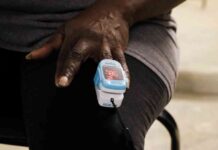Extreme heat is becoming an increasingly pressing issue in the United States, with record-breaking temperatures putting millions of Americans at risk for long-term health problems. Particularly in the South and Southeast regions of the country, including states like Florida, Georgia, Kentucky, Mississippi, Oklahoma, Texas, Virginia, and the Carolinas, heat warnings have become a common occurrence. This Labor Day, the National Weather Service has issued alerts for these areas, highlighting the dangers that extreme heat poses to individuals with chronic health conditions.
While high temperatures can be hazardous for anyone, those living in states with already high rates of chronic diseases such as diabetes, heart disease, and kidney disease face a heightened risk during heat waves. In states like Alabama, Georgia, Louisiana, Mississippi, and South Carolina, the prevalence of these conditions is among the highest in the nation. Dr. John Sherner, chair of medicine at MedStar Washington Hospital Center, explains, “People who have chronic health conditions are going to be more susceptible, particularly when you get sustained high-heat, high-humidity days. Their body is not going to be able to regulate temperature as tightly, so when the environment gets hotter, they’re going to get hotter more quickly.”
The combination of extreme heat and underlying health issues can have serious consequences. The body’s natural response to heat is to dilate blood vessels in order to expel internal heat through the skin, causing the heart to work harder. In the Southern and Southeastern states, where a significant portion of the population already struggles with chronic illnesses, this increased strain on the heart can be particularly dangerous. For example, individuals with heart failure, a condition that impairs the heart’s ability to pump oxygen-rich blood efficiently, may face even greater challenges in regulating their body temperature during heat waves.
According to data from the Centers for Disease Control and Prevention, older adults on Medicare living in Southern and Eastern states have the highest rates of hospitalization for heart failure in the country. Dr. Joanne Skaggs, associate chief medical officer of adults at OU Health University of Oklahoma Medical Center, notes that hospitals are seeing a rise in cases of heart failure and dehydration-related issues during heatwaves, putting additional strain on already overwhelmed healthcare systems. Patients with diabetes or other chronic conditions are at an increased risk for heat-related complications, making it crucial for individuals to take precautions to protect their health during extreme heat events.
In some cases, the consequences of extreme heat can be severe. Dr. David Obert of the University Medical Center of Southern Nevada recalls a tragic incident where an elderly couple developed significant kidney failure after their air conditioner broke, and they remained in their hot house for several days. These heartbreaking stories highlight the urgent need for individuals to be aware of the risks associated with heat exposure and take proactive measures to stay safe.
The growing frequency and intensity of heatwaves in recent years have raised concerns about the impact of extreme heat on public health. 2023 was recorded as the hottest year ever, according to the National Oceanic and Atmospheric Administration, with a high likelihood that 2024 will surpass that record. Kimberly McMahon, public program manager at NOAA’s National Weather Service, emphasizes the urgent need to address the deadly consequences of heatwaves, stating, “Unfortunately, this is a cycle that we can’t seem to break.”
In response to the escalating threat of extreme heat on public health, the National Integrated Heat Health Information System has developed a federal strategic plan aimed at addressing critical issues related to heat-related illnesses. McMahon, who serves as a co-chair of the initiative, questions why despite advances in forecasting technology, heat-related deaths continue to occur at alarming rates. It is clear that more needs to be done to protect vulnerable populations from the dangers of extreme heat.
To mitigate the risks associated with extreme heat, it is essential for individuals to take proactive measures to stay safe. Some key tips include staying hydrated by drinking plenty of water, recognizing the signs of heat-related illnesses such as cramping, muscle spasms, dizziness, headaches, weakness, nausea, and confusion, and seeking help if access to air conditioning or other cooling methods is limited. By being informed and prepared, individuals can reduce their risk of heat-related complications and protect their health during extreme weather events.
In conclusion, the impact of extreme heat on individuals with chronic health conditions in America’s population is a critical issue that requires immediate attention. As temperatures continue to rise and heatwaves become more frequent and intense, it is essential for policymakers, healthcare providers, and individuals alike to take proactive steps to protect vulnerable populations from the dangers of extreme heat. By raising awareness, implementing effective strategies, and prioritizing public health, we can work towards creating a safer and healthier future for all.

















